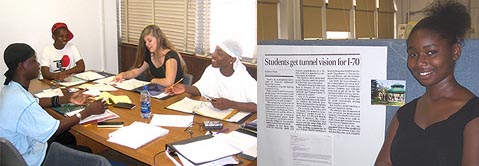
DENVER, CO—Young people today are in a powerful position when it comes to changing public opinion. Their views are fresh, and they are new to the scene. Their passionate, creative (and at times, combative) energy is rich fuel for revisiting ideas that adults may take for granted. For many youth, ideas of justice are strong and intuitive.
Yet when one grows old enough to notice negative trends—the tendency for minority youth to play criminals on television, for example, or for polluting factories to lodge in poor neighborhoods—it is easy to move from awareness to a feeling of powerlessness. Social and environmental problems are so large. You’ve just become aware of the world, and this is how it looks? You’re overwhelmed!
That is precisely the moment when youth need to learn a certain, vital set of skills for becoming producers of knowledge, rather than simply consumers of it. They are eager to learn what the building blocks of the story are, how to rearrange them, and how to rewrite it. The two projects profiled below illustrate this work in action, as two groups of students in urban Denver worked changing public opinion on important issues. The support of Student Research for Action grants from What Kids Can Do and the Bill & Melinda T. Gates Foundation allowed teens to put their ideas of justice into motion.
At Millennium Quest High School, students conducted an environmental impact survey of a proposed highway expansion through a poor neighborhood, and held a press conference to present their alternative proposals. At Skyland Community High School, students surveyed and interviewed their peers to determine the emotional reasons—not the reasons motivated by race or poverty—why kids drop out or stay in school. In both of these cases, young people used research to break problems down into manageable questions, developed skills to turn inquiry into action, and offered unique solutions.
Consider a condemned highway bridge, a polluted Denver neighborhood, and city plans for growth which don’t take low-income citizens into account. Mix these together with a group of teenagers who bring questions, attitude, and fresh energy to the civic process. What do you get? A new kind of environmental activism, and some determined, unexpected new leaders.
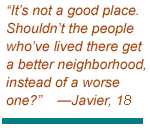 This spring, 80 kids at Millennium Quest High School in inner city Denver formed fourteen teams to tackle the issue of what to do about a crumbling section of Interstate 70. The city planned to alter and expand the bridge by demolishing parts of the Elyria-Swansea neighborhood, but the students, who did an environmental impact survey of the area, had other ideas.
This spring, 80 kids at Millennium Quest High School in inner city Denver formed fourteen teams to tackle the issue of what to do about a crumbling section of Interstate 70. The city planned to alter and expand the bridge by demolishing parts of the Elyria-Swansea neighborhood, but the students, who did an environmental impact survey of the area, had other ideas.
Javier, 18, has been walking under the bridge since he was a child. “The concrete is cracking, and when you walk under it, you can get splashed by the diesel coming through the cracks. It’s not a good place. Shouldn’t the people who’ve lived there get a better neighborhood, instead of a worse one?”
These teenagers know what they’re talking about. Like Javier, a number of students on the team live in zip code 80216, considered the most blighted urban neighborhood in the state of Colorado. Elyria-Swansea is a community challenged already by three toxic Superfund sites and the presence of a Purina factory, which fills the air for blocks around with the odor of processing meat. Cancer rates are elevated and basic services lacking. Millennium Quest draws its learners from numerous surrounding communities, yet even students who live in less polluted areas got fired up about protecting Elyria-Swansea.
Juan, 14, said, “We went around the Swansea and saw all the places that are polluted: we smelled them, and walked around. The bridge is in folk’s backyards! You never get any learning done if you live under a highway.”
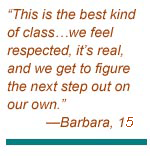 Teacher Oliveann Slotta and three others guided the student teams in a step-by-step process. She said, “The first stage was to bring in people who knew about the issue from all perspectives, and let them fight it out in front of the kids. Next the kids researched the situation using science, social studies and math. They paired with community-based environmental organizations, took a “Toxic Tour” on the bus, and went around the neighborhood interviewing residents. Then, they evaluated all of their findings and came up with recommendations of better options that would serve the community.” This active, interdisciplinary approach lets kids discover their strengths and use their own initiative.
Teacher Oliveann Slotta and three others guided the student teams in a step-by-step process. She said, “The first stage was to bring in people who knew about the issue from all perspectives, and let them fight it out in front of the kids. Next the kids researched the situation using science, social studies and math. They paired with community-based environmental organizations, took a “Toxic Tour” on the bus, and went around the neighborhood interviewing residents. Then, they evaluated all of their findings and came up with recommendations of better options that would serve the community.” This active, interdisciplinary approach lets kids discover their strengths and use their own initiative.
“This is the best kind of class, way better than sitting in a chair staring at the ceiling,” Barbara, 15, mused. “We feel respected, it’s real, and we get to figure the next step out on our own.”
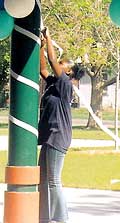 In science, the students used Palm Pilots and probes to test soil and air, and studied how groundwater contamination can be cleaned. In math, they deciphered the nuts and bolts of project financing. The kids who decoded the budget discovered that a raise in Denver sales tax would fund the bridge expansion, and this deepened their grasp of its impact on people’s actual lives.
In science, the students used Palm Pilots and probes to test soil and air, and studied how groundwater contamination can be cleaned. In math, they deciphered the nuts and bolts of project financing. The kids who decoded the budget discovered that a raise in Denver sales tax would fund the bridge expansion, and this deepened their grasp of its impact on people’s actual lives.
Social studies brought the students to an understanding of eminent domain (the city’s right to reclaim any land), zoning, and environmental racism. Chauncy, 14, said, “They were gonna kick people out of their houses and give them only $15,000 to move. That’s not enough to buy a new house. That’s cold! But as we were studying this, it seemed to be okay to do whatever you want in a place where poor people or minorities live—now, why is that?”
With two local non-profit organizations as mentors, students lobbied the Mayor’s office, the Regional Transportation District, and the community relations office of Denver International Airport. They also hit the sidewalks, interviewed local business owners and residents, and organized community support, from the elementary school to the ice cream factory.
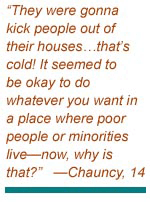 Javier, 18, says, “We have connections now. We can call up people. We can take it to the media, or write a paragraph to the newspaper. We know what to do when something isn’t right.”
Javier, 18, says, “We have connections now. We can call up people. We can take it to the media, or write a paragraph to the newspaper. We know what to do when something isn’t right.”
Ashanti, 15, adds, “We need to know how to do this stuff cause when we have kids, there might be a building or a playground they go to that is polluted. Or they might build a prison in our neighborhood, when we don’t want it.”
Developing a critical environmental consciousness in urban teenagers is not the easiest task. Far from the idyllic mountains and flowers of nature calendars, this kind of environmentalism has more to do with seeing an ecosystem where others see a dead-end road; knowing the impact of auto emissions in air and water; and being willing to take a stand as a community defender. But these challenges do not deter Chauncy, 14; whose favorite TV show is Captain Planet. He says, “If being an environmentalist is a job, then I want to do it. Where can I sign up?”
In May the Millennium Quest teams held a press conference. Students wore blue T-shirts they’d designed with the slogan, “Get Around on the Underground.” The kids had two solutions to propose to city planners: a decked bridge with light rail on the top, and a tunnel that would divert both traffic and pollution underground, and preserve the homes flanking the highway. Reporters from the Rocky Mountain News came to see what they had to say, and were impressed. A week later, the newspaper ran an article profiling the issue, and their work went public. Slotta said, “The students went wild with excitement. They got to see their own impact as community activists: people paying attention to what they have to say.”
The students were unanimous about the benefits of working on real-world problems in school. Eighty kids gained the skills to analyze a public issue, participate in democracy, and defend all residents' rights to health. When asked how they liked this kind of learning, with its complications and changing conditions, Kameron, 16, grinned and said, “It’s very cool. It’s a feeding frenzy for your brain.”
Sherina, 14, wrote an impromptu poem: “The neighborhood is nice, I wouldn’t think twice about the way it looks. / Being in the neighborhood is better than reading books! / My fellow citizens, get involved. / ‘Cuz if you don’t, you will regret it in the long haul!”
Although they may end up not changing the city’s plans for the new bridge, the project has been a success—and city leaders know they’re here.
Click here for students’ press release and sample essays
Click here for “toxic tour” assignment [PDF]
Click here for project’s learning objectives and research wrap-up [PDF]
Another group of Denver teens is also asking tough questions about social problems—and this time, they are looking to themselves and their friends for answers.
At Skyland Community High School, tucked into one corner of a wide, low, 1940’s civic building on a quiet, leafy side street, six students want to know the real reasons why kids drop out of high school, and what can make them stay. They are interviewing and surveying their peers on the subject, and looking deeply into their responses for patterns that could provide important clues to this pervasive problem.
These researchers are uniquely poised to investigate the issue. Many students at Skyland are getting a second chance at finishing high school. Some have lost parents to death or jail; some have overcome addiction issues or gang involvement. Some have children of their own to care for. Others simply wanted a different learning environment. But all have come to Skyland because a traditional high school setting did not work for them.
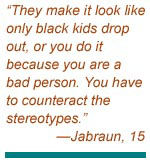 Jabraun, 15, said, “There’s a lot of stereotypes about drop-outs that make you think they’re criminal, or it’s racial. They make it look like only black kids drop out, or you do it because you are a bad person. You have to counteract the stereotypes.”
Jabraun, 15, said, “There’s a lot of stereotypes about drop-outs that make you think they’re criminal, or it’s racial. They make it look like only black kids drop out, or you do it because you are a bad person. You have to counteract the stereotypes.”
The student researchers came up with a new hypothesis: that it is being known that causes students to stay in school, or leave it.
It makes sense that this idea emerged for students at Skyland. Here, kids learn through one-on-one teacher and student relationships, community internships, and volunteering. There are only sixty students, and each has an individual plan. Infused with support, they have 24/7 access to their advisors. There are no grades, bells, or uniforms. Developing self-respect and taking responsibility for one’s learning are touchstones of the Skyland philosophy. For students not so lucky—or for these students, before they came to this innovative program—school may seem an impossible hurdle, or a waste of valuable time.
Anna, 14, said, “A lot of kids drop out because nobody knows who they are, and they go through the whole day and nobody is nice to them. Nobody says, How are you?”
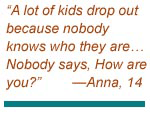 With the help of advisor Amber Kim, six Skyland students applied for a Student Research for Action grant to test their hypothesis in the field. Talking with those who attend or have abandoned school, they aim to find out whether teenagers feel that a teacher cares about them and knows them as an individual, or not. The students first interviewed Skyland students, and then stepped out to find high schoolers in other places.
With the help of advisor Amber Kim, six Skyland students applied for a Student Research for Action grant to test their hypothesis in the field. Talking with those who attend or have abandoned school, they aim to find out whether teenagers feel that a teacher cares about them and knows them as an individual, or not. The students first interviewed Skyland students, and then stepped out to find high schoolers in other places.
Confidence mounts for the student team as their technical skills grow. With the help of Dr. Gary Lichtenstein, education professor at the University of Denver, they’ve learned how to develop interview questions, conduct formal interviews, tape record, and transcribe. They have crafted a survey, and are tabulating and coding results.
Leah, 14, says, “Every Thursday we destroy a table with interviews, transcripts, and all our stuff. We could survey the whole world. But it’s always crazy piles of paper, everywhere.”
Interpersonal abilities are nurtured by the work as well. Angelo, 15, is tall, very soft-spoken, and described as “the quietest boy in the school.” He says of interviewing, “It’s hard when you’re shy—I feel nervous and tight, not as loose as you would be with friends. But I used to be a lot shyer and now I’m able to talk more openly. I guess you could say I came out of my shell.” In fact, in April 2004, Angelo and Leah gave a workshop on interview techniques and qualitative research at a meeting in Houston that gathered students and teachers nationwide who are working to improve their schools. They were one of four student groups selected to make a presentation.
 It’s easy to see that the answers this team gets to the tough questions they pose to other teenagers might be different from those that adult researchers or sociologists would receive. They are close enough in age and experience; they know the stresses of the streets. They are not going to objectify the other kids with rough lives that they’re talking to. At times, they’re friends with the people they are interviewing.
It’s easy to see that the answers this team gets to the tough questions they pose to other teenagers might be different from those that adult researchers or sociologists would receive. They are close enough in age and experience; they know the stresses of the streets. They are not going to objectify the other kids with rough lives that they’re talking to. At times, they’re friends with the people they are interviewing.
This element of friendship is an important one for the project, and signals the broader hungers behind the focused inquiry. Their motivation is not just research. The teens of No Drop-Outs Here have bigger visions: they want young people to stay in school because they want them to have good lives, and they want a better world to live in.
Anna, 16, says, “I want to keep people in schools. We would have more doctors and teachers if people stayed in school. We’d have more people that could give the community what it needs.”
Leah, 15, says, “I want people to stay in school because education results in what President we get. All our Presidents have been “he’s” up till now. One day they won’t have to be “he” or be just making war. If people learn, they can make good choices about who gets to be President.”
Angelo, 15, says, “Staying in school can be hard. But otherwise you will never know what you can make of yourself, and you’ll be disappointed in yourself, even if you don’t know why.” As for himself, Angelo is planning to continue on to college—and hoping to study education, with Dr. Lichtenstein as his mentor.
Click here for interview protocol and survey [PDF]
This story was written by Abe Louise Young, a poet and freelance writer who lives in Austin, Texas. In June 2004 she traveled to Denver, Colorado to meet with students and teachers who had received a Student Action Research grant for this project—part of a three-year joint initiative of What Kids Can Do and the Bill & Melinda Gates Foundation.




